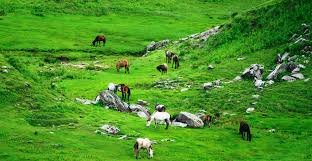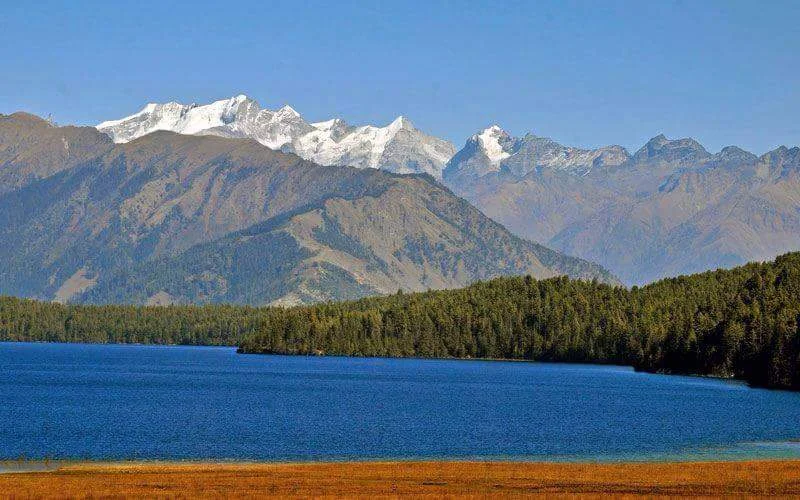Tucked away in the remote hills of western Nepal’s Karnali Province lies Khaptad National Park, a breathtaking sanctuary where nature and spirituality harmoniously blend. Unlike the bustling trekking routes of Everest or Annapurna, Khaptad offers a tranquil, less-traveled path for those seeking pristine landscapes, rich biodiversity, and spiritual rejuvenation.
Known as one of the most peaceful and untouched national parks in Karnali, Khaptad National Park attracts not only nature lovers but also spiritual seekers drawn to its sacred sites and meditation centers. This post is your comprehensive guide to exploring the Khaptad trek, understanding why it’s a must-visit destination, and learning the best time to visit Khaptad for an unforgettable experience.

Khaptad National Park
Where is Khaptad National Park and Why Visit?
Khaptad National Park spans over 225 square kilometers across the districts of Doti, Bajhang, Bajura, and Achham in Karnali Province. Its diverse landscape features rolling hills, alpine meadows, dense rhododendron forests, and sparkling streams. The park’s high-altitude grasslands and sacred temples make it a unique place where visitors can immerse themselves in both natural beauty and deep spirituality.
Here’s why Khaptad National Park should be on your travel list:
Rich Biodiversity: The park is home to various wildlife including Himalayan black bears, leopards, barking deer, and over 200 bird species such as the colorful Himalayan Monal. Botanists will appreciate the abundance of medicinal herbs thriving in the park.
Spiritual Heritage: Khaptad Baba, a revered saint, spent decades meditating here, and his ashram still serves as a spiritual retreat. The park houses several ancient temples and meditation caves, making it one of the most important spiritual places in Nepal.
Off-the-Beaten-Path Trekking: Unlike popular trekking regions, the Khaptad trek offers solitude and untouched wilderness. It’s a perfect destination for travelers who want to escape crowds and experience authentic Nepalese culture in remote villages.
The Khaptad Trek: What to Expect
The Khaptad trek is a moderate journey through hills and meadows dotted with wildflowers and surrounded by forests of rhododendron and pine. This trek typically takes 4 to 7 days depending on the route and your pace.
Trek Highlights:
Khaptad Baba Ashram: The spiritual heart of the park, this serene retreat is where the saint Khaptad Baba meditated and taught. Many visitors spend time here in quiet reflection or meditation.
Scenic Meadows and Forests: During spring, the rhododendron blooms create a stunning red carpet along the trails. Autumn offers clear skies with panoramic views of the Himalayas.
Wildlife Watching: The park is a haven for birdwatchers and wildlife enthusiasts, with frequent sightings of unique species.
Cultural Encounters: Small villages along the trek offer warm hospitality and a glimpse into rural life in Karnali.
Best Time to Visit Khaptad National Park
Planning your visit during the right season is key to enjoying the Khaptad trek fully. Here’s a quick guide to the best time to visit Khaptad:
Spring (March to May): This is arguably the best time, as the rhododendrons bloom vibrantly and the weather is mild and pleasant.
Autumn (September to November): Clear skies and comfortable temperatures make this season ideal for trekking and photography.
Winter (December to February): While cold and snowy, winter offers solitude but requires preparation for chilly nights.
Monsoon (June to August): The park is lush and green, but trails can be slippery, and rain may disrupt travel plans.
How to Reach Khaptad National Park
Getting to Khaptad National Park requires some planning due to its remote location:
The nearest major airports are Dhangadhi and Dipayal, both accessible by domestic flights from Kathmandu.
From these towns, local buses or jeeps can take you closer to the park’s entry points.
The trek itself begins in nearby villages such as Khalanga or Jumla, depending on your chosen route.
Hiring a local guide is highly recommended to navigate the trails safely and to enrich your experience with local knowledge.
Accommodation and Facilities on the Khaptad Trek
Accommodation in and around Khaptad National Park is basic but comfortable. Teahouses and lodges provide simple meals, warm beds, and a place to rest after a day on the trail. Camping is also an option for those who prefer to stay closer to nature.
Expect limited mobile connectivity and facilities, so be sure to carry essentials like water purification tablets, sunscreen, and appropriate clothing for variable weather.
Tips for a Successful Khaptad Trek
Prepare for altitude: The highest points of the trek reach around 3,500 meters. Take time to acclimatize and avoid altitude sickness.
Respect local customs: The park is a sacred area for many Nepalese people, so dress modestly and behave respectfully, especially near temples and monasteries.
Travel light: Pack only what you need to keep your trek comfortable.
Leave no trace: Help keep Khaptad National Park pristine by carrying out your waste.
Why Khaptad National Park is a Must-Visit
Khaptad National Park offers a rare combination of natural beauty, wildlife, and spiritual tranquility. It is one of Nepal’s best-kept secrets and a jewel among the national parks in Karnali. Whether you’re an avid trekker looking for solitude, a nature enthusiast eager to spot unique flora and fauna, or a spiritual traveler seeking inner peace, Khaptad will exceed your expectations.
Exploring Khaptad National Park through the Khaptad trek is a journey that touches the body, mind, and soul. Away from crowded tourist trails, it offers pristine landscapes, rich biodiversity, and a deep connection to Nepal’s spiritual heritage. If you’re planning your next adventure, consider Khaptad National Park a hidden paradise where nature and spirituality truly meet.


